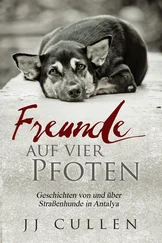“It was like they were carrying out executions,” another boy in the room said. “You would hear a shot. Then there would be quiet. Then another shot. Bam. Bam. Bam.”
The screaming and gunfire both stopped. Silence, then more explosions. On and off and on again. The fire alarm began blaring. It was an earsplitting pitch designed to force people out of the building through sheer pain. The teachers and students could barely hear anything over the alarm’s shriek, but could just make out the steady flap of helicopters outside.
Someone turned on the giant TV suspended from the ceiling. They kept the volume off but the subtitles on. It was their school, from the outside. Much of the class was transfixed at first, but their attention waned quickly. Nobody seemed to know anything.
Aaron called his father, who used another line to call 911, so that paramedics could ask questions and relay instructions. Several other students and teachers called the cops. The science room group remained linked to authorities via multiple channels throughout the afternoon.
Sophomore Kevin Starkey, also an Eagle Scout, assisted Aaron. “You’re doing all right,” the boys whispered to Dave. “They’re coming. Just hold on. You can do it.” They took turns applying pressure, digging their palms into his wounds.
“I need help,” Dave said. “I’ve got to get out of here.”
“Help is on the way,” Aaron assured him.
Aaron believed it was. Law enforcement was first alerted to Dave’s predicament around 11:45. Dispatchers began responding that help was “on the way” and would arrive “in about ten minutes.” The assurances were repeated for more than three hours, along with orders that no one leave the room under any circumstances. The 911 operator instructed the group to open the door briefly: they were to tie a red shirt around the doorknob in the hallway. The SWAT team would look for it to identify the room. There was a lot of dissent about that directive in Science Room 3. Wouldn’t a red flag also attract the killers? And who was going to step out into that hallway? They decided to obey. Someone volunteered to tie the shirt to the doorknob. Around noon, teacher Doug Johnson wrote 1 BLEEDING TO DEATH on the whiteboard and moved it to the window, just to be sure.
Occasionally the TV coverage grabbed attention in the room. At one point, Marjorie Lindholm thought she spotted a huge mass of blood seeping out a door pictured on-screen. She was mistaken. Fear had taken control.
Each time Aaron and Kevin switched positions, they felt Dave’s skin grow a little colder. He was losing color, taking on a bluish cast. Where are the paramedics? they wondered. When will the ten minutes be up? Dave’s breathing began to slow. He drifted in and out. Aaron and Kevin rolled him gently on the tile floor to keep him conscious and to keep his airway clear. He couldn’t remain on his back for very long or he would choke on his own blood.
They pulled out wool safety blankets from a first-aid closet and wrapped him up to keep him warm. They asked him about coaching, teaching, anything to keep him engaged and stave off shock. They slipped his wallet out and began showing him pictures.
“Is this your wife?”
“Yes.”
“What’s your wife’s name?”
“Linda.”
He had lots of pictures, and they used them all. They talked about his daughters and his grandchildren. “These people love you,” the boys said. “This is why you need to live.”
Aaron and Kevin grew desperate. The treatment had exceeded scouting instruction. “You’re trained to deal with broken arms, broken limbs, cuts and scrapes—stuff you get on a camping trip,” Aaron said. “You never train for gunshot wounds.”
Eventually, Aaron and Kevin lost the struggle to keep Dave conscious. “I’m not going to make it,” Dave said. “Tell my girls I love them.”
____
It was relatively calm for a while. The alarm kept blaring, the choppers kept thumping, and gunfire or explosions would periodically rumble through the hallways, somewhere off in the distance. Nothing had sounded particularly close for a while; nothing seemed imminent. Dave’s chest rose and fell, blood oozed out, but the boys could not rouse him. Aaron and Kevin kept trying.
Some of the kids gave up on police. Around 2:00 P.M., they informed the 911 operator they were going to hurl a chair through the window and get Dave out themselves. She insisted they abandon the plan, which she warned them might draw the attention of the killers.
At 2:38, the TV suddenly caught the room’s attention again. Patrick Ireland was tumbling out the library window. “Oh my God!” some of the kids yelled. They’d hidden quietly for hours, but this was too much. Coach Sanders was not an isolated case. A kid was just as bloody just down the hall. They had assumed it was bad out there; now they had proof. Some kids closed their eyes, pictured loved ones, and silently said good-bye.
Just a few minutes later, the danger suddenly drew close again: screams erupted from the next room. Then everything went silent for a minute. All at once, the door burst open and men in black rushed in. The killers were dressed in black. The invaders toted submachine guns. They waved them at the students, shouting fiercely, trying to outscream the fire alarm. “I thought they were the gunmen,” Marjorie Lindholm wrote later. “I thought that now I was going to die.”
Some of the men turned and pointed to the huge block letters on their backs: SWAT .
“Be quiet!” an officer yelled. “Put your hands on your heads and follow us out.”
“Someone’s got to stay with Mr. Sanders,” someone said.
“I will,” Aaron volunteered.
“No!” an officer said. “Everyone out.”
Then how about hauling Dave out with them, Kevin suggested. There were folded tables—they could improvise one as a stretcher.
No.
It seemed heartless, but the SWAT team was trained to make practical choices. Hundreds of students were trapped. The gunmen could reappear any moment. The team had to assume a battlefield mentality and evacuate the maximum number in the minimum time. They could send a medic back for the injured later.
The SWAT team led students single file down the stairs to the commons. They waded through three inches of water that had rained down from the sprinklers. Backpacks and pizza slices floated by. Don’t touch them, the officers warned. Don’t touch anything . A SWAT member held the door. He stopped each student, held them for two seconds, then tapped them on the shoulder and told them to run. That was a standard infantry maneuver. A single pipe bomb could take out an entire pack of children; a well-aimed machine-gun burst could do the same. Safer to space them.
Outside, the kids ran past two dead bodies: Danny Rohrbough and Rachel Scott. Marjorie Lindholm remembered “a weird look on their faces, and a weird color to their skin.” The girl just ahead of her stopped suddenly when she saw the bodies, and Marjorie caught up. A SWAT officer screamed at them to keep moving. Marjorie saw their guns trained right on her. She gave the girl a push, and they both took off.
Two SWAT officers stayed with Dave, and another called for help. It fell to a Denver SWAT member outside the building to recruit a paramedic. He spotted Troy Laman, an EMT who had driven out from the city and was manning a triage station. “Troy, I need you to go in,” the SWAT officer said. “Let’s go.”
Laman followed the officer through the flooded commons, up the stairway, past the rubble, and into Science Room 3. By that time, Dave had stopped breathing. According to emergency triage protocol, that qualified him as dead. “I knew there was nothing I could do for this guy,” said Laman, who had no equipment. “But because I was stuck in a room with him by myself for fifteen minutes, I wanted to help him.”
Читать дальше







